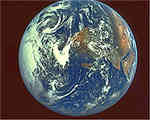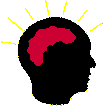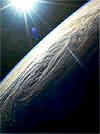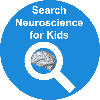| While Glenn is providing important
scientific data by being the oldest person in space, and his medical
records from the past 50 years give a written record to compare with his
present physical state, it must be noted that he only provides one data
point. What does this mean?
 Basically, Glenn is only one person, and one cannot draw strong
conclusions from data obtained from only one person. For instance, if the
doctors find something unusual with how Glenn absorbs the amino acids in
his muscles, that could be because of his space travel, or it could be
something unique to Glenn, or unique to men. It is not until you have
several people to compare that you can make a general conclusion and apply
it to a wider population.
Basically, Glenn is only one person, and one cannot draw strong
conclusions from data obtained from only one person. For instance, if the
doctors find something unusual with how Glenn absorbs the amino acids in
his muscles, that could be because of his space travel, or it could be
something unique to Glenn, or unique to men. It is not until you have
several people to compare that you can make a general conclusion and apply
it to a wider population.
That is why the space experiments try to involve as many astronauts as
possible--so there will be more people to provide data for comparisons; a few of
the astronauts will not participate in certain studies so that they are
the control group. A control group does everything the same except for the
experimental part, the variable. So if a few people take amino acids, a few people will not, yet they are spending the same time in space, eating the same food, doing the same
activities, so that everything is the same except for the variable, which
is taking amino acids. That way, if there is a difference between the
groups, you should be able to conclude that it is a result of the amino
acids, not anything else. |


 Glenn is not the only
one doing experiments. There are more than 80
experiments on the shuttle. Some astronauts are
researching how balance is affected in zero-gravity; research with
fish also will help shed light on this topic. Your sense of balance and
knowing where you body is in relation to the floor (imagine yourself on a
boat that is rocking in the water...your body senses the motion and your
brain sends signals to your muscles to adjust so that you do not fall) is
a cooperative effort of your inner ear, which senses motion; your brain,
which processes the information; and your muscles, which contract to keep
you upright.
Glenn is not the only
one doing experiments. There are more than 80
experiments on the shuttle. Some astronauts are
researching how balance is affected in zero-gravity; research with
fish also will help shed light on this topic. Your sense of balance and
knowing where you body is in relation to the floor (imagine yourself on a
boat that is rocking in the water...your body senses the motion and your
brain sends signals to your muscles to adjust so that you do not fall) is
a cooperative effort of your inner ear, which senses motion; your brain,
which processes the information; and your muscles, which contract to keep
you upright. A second area of research
is muscle atrophy. Atrophy means deterioration
or wasting--literally, "lack of food." This occurs when people age or are
immobile, such as being bedridden or paralyzed. Glenn has been taking
amino acids (one is ingested, or swallowed, and one is injected by a shot),
which are the basic units from which proteins are formed. Scientists want to
see how the amino acids, alanine and histidine, are incorporated in his
muscle and how fast they break down.
A second area of research
is muscle atrophy. Atrophy means deterioration
or wasting--literally, "lack of food." This occurs when people age or are
immobile, such as being bedridden or paralyzed. Glenn has been taking
amino acids (one is ingested, or swallowed, and one is injected by a shot),
which are the basic units from which proteins are formed. Scientists want to
see how the amino acids, alanine and histidine, are incorporated in his
muscle and how fast they break down.
 Brain cells generate electrical activity that indicate the brain's state
of activity. The electrodes detect the brain waves. A record of the brain
waves is called an
Brain cells generate electrical activity that indicate the brain's state
of activity. The electrodes detect the brain waves. A record of the brain
waves is called an  Basically, Glenn is only one person, and one cannot draw strong
conclusions from data obtained from only one person. For instance, if the
doctors find something unusual with how Glenn absorbs the amino acids in
his muscles, that could be because of his space travel, or it could be
something unique to Glenn, or unique to men. It is not until you have
several people to compare that you can make a general conclusion and apply
it to a wider population.
Basically, Glenn is only one person, and one cannot draw strong
conclusions from data obtained from only one person. For instance, if the
doctors find something unusual with how Glenn absorbs the amino acids in
his muscles, that could be because of his space travel, or it could be
something unique to Glenn, or unique to men. It is not until you have
several people to compare that you can make a general conclusion and apply
it to a wider population.

![[email]](./gif/menue.gif)


